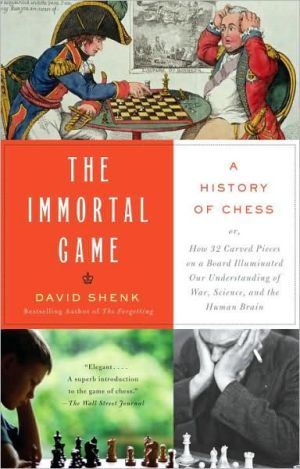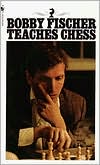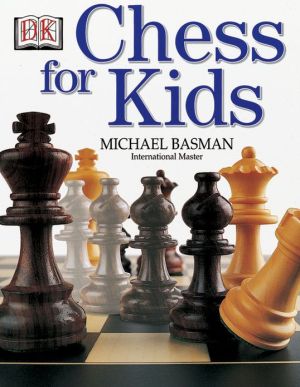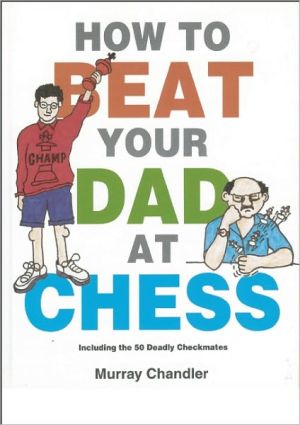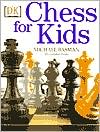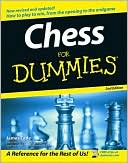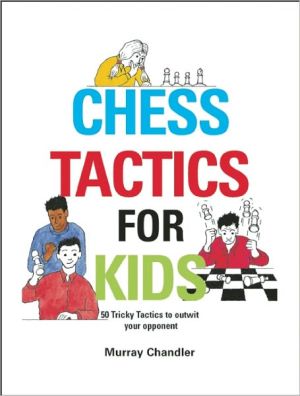Immortal Game: A History of Chess or How 32 Carved Pieces on a Board Illuminated Our Understanding of War, Art, Science, and the Human Brain
Chess is the most enduring and universal game in history. Here, bestselling author David Shenk chronicles its intriguing saga, from ancient Persia to medieval Europe to the dens of Benjamin Franklin and Norman Schwarzkopf. Along the way, he examines a single legendary game that took place in London in 1851 between two masters of the time, and relays his own attempts to become as skilled as his Polish ancestor Samuel Rosenthal, a nineteenth-century champion. With its blend of cultural history...
Search in google:
A surprising, charming, and ever-fascinating history of the seemingly simple game that has had a profound effect on societies the world over. Why has one game, alone among thousands of games played throughout human history, not only survived, but thrived within every culture it has touched? Chess has been a remarkably omnipresent factor in the development of civilization since its invention, and David Shenk unearths the hidden history of a game that has influenced everything from mathematics to military strategies, computer science, and art. The New York Times - Katie Hafner Critics may point out that Shenk himself isn t much of a chess player, as he readily admits. But a popular survey like this one doesn t need a grandmaster, and Shenk, a spry writer who has also written books on Alzheimer s disease, technology and other subjects, has a good sense of what might interest a general reader. Although the book s subtitle promises a history of chess, its more interesting pages offer something closer to meditation, personal revelation and the exploration of what he calls "the deep history of chess s entanglement with the human mind."
The Immortal Game\ \ By David Shenk \ Random House\ David Shenk\ All right reserved.\ ISBN: 0385510101 \ \ \ Chapter One\ 1.\ \ "UNDERSTANDING IS THE ESSENTIAL WEAPON"\ Chess and Our Origins\ \ \ When Sissa had invented chess and produced it to King Shihram, the latter was filled with amazement and joy. He ordered that it should be preserved in the temples, and held it the best thing that he knew as a training in the art of war, a glory to religion and the world, and the foundation of all justice.\ --ibn Khallikan, thirteenth century\ \ \ Stories do not exist to tell the facts, but to convey the truth. It is said that in ancient India, a queen had designated her only son as heir to the throne. When the son was assassinated, the queen's council searched for the proper way to convey the tragic news to her. They approached a philosopher with their predicament. He sat for three days in silent thought, and then said: "Summon a carpenter with wood of two colors, white and black."\ \ The carpenter came. The philosopher instructed him to carve thirty-two small figurines from the wood. After this was done, the philosopher said to the carpenter, "Bring me tanned leather," and directed him to cut it into the shape of a square and to etch it with sixty-four smaller squares.\ \ He then arranged the pieces on the board and studied them silently. Finally, he turned to his disciple and announced, "Thisis war without bloodshed." He explained the game's rules and the two began to play. Word quickly spread about the mysterious new invention, and the queen herself summoned the philosopher for a demonstration. She sat quietly, watching the philosopher and his student play a game. When it was over, one side having checkmated the other, the queen understood the intended message. She turned to the philosopher and said, "My son is dead."\ \ "You have said it," he replied.\ \ The queen turned to the doorkeeper and said, "Let the people enter to comfort me."\ \ The annals of ancient poetry and weathered prose are filled with many such evocative chess stories, stretched over 1,400 years. Over and over, chess was said to have been invented to explain the unexplainable, to make visible the purely abstract, to see simple truths in complex worlds. Pythagoras, the ancient mathematician heralded as the father of numbers, was supposed to have created the game to convey the abstract realities of mathematics. The Greek warrior Palamedes, commander of troops at the siege of Troy, purportedly invented chess as a demonstration of the art of battle positions. Moses, in his posture as Jewish sage, was said to have invented it as a part of an all-purpose educational package, along with astronomy, astrology, and the alphabet.\ \ Chess was also considered a window into other people's unique thoughts. There is the legend of the great medieval rebbe, also a cunning chess player, whose son had been taken away as a young boy and never found. Many decades later, the rebbe was granted an audience with the pope. The two spoke for a while, and then decided to play a game of chess. In their game the pope played a very unusual combination of moves which, to any other opponent, would have been astonishing and overpowering. But the strange combination was not new to the rebbe; he had invented it, in fact, and had shared it only with his young son. The pope, they both instantly realized, was the rebbe's long lost child.\ \ And there are hundreds--maybe thousands--more. Hearing these stories, we care less about whether they are completely true and more about what they say. Myths, said Joseph Campbell, "represent that wisdom of the species by which man has weathered the millenniums." Chess myths, in particular, tell us first that chess goes way, way back, and that it has always been regarded not just as a way to pass the time, but also as a powerful tool for explanation and understanding. While chess is ostensibly about war, it has for 1,400 years been deployed as a metaphor to explore everything from romantic love to economics. Historians routinely stumble across chess stories from nearly every culture and era--stories dealing with class consciousness, free will, political struggle, the frontiers of the mind, the mystery of the divine, the nature of competition, and, perhaps most fundamentally, the emergence of a world where brains often overcome brawn. One need not have any passion for the game itself to be utterly captivated by its centuries of compelling tales, and to appreciate its importance as a thought tool for an emerging civilization. Chess is a teaching and learning instrument older than chalkboards, printed books, the compass, and the telescope.\ \ As a miniature reflection of society, it was also considered a moral guidepost. Yet another myth has chess invented to cure the cruelty of Evil-Merodach, a vile Babylonian king from the sixth century b.c. who murdered his father King Nebuchadnezzar and then disposed of his body by chopping it into three hundred pieces and feeding the pieces to three hundred vultures. Desperate to curb the brutality of his new leader, the wise man Xerxes created chess in order to instill virtues and transform him into a just and moral ruler: Here is how a king behaves toward his subjects, and here is how his grateful subjects defend their just king . . .\ \ Separately, each chess myth conveys a thousand truths about a particular moment in time where a society longed to understand something difficult about its own past--the source of some idea or tool or tradition. Taken together, they document our quest to understand--and explain--abstraction and complexity in the world around us. The paradox of illuminating complexity is that it is inherently difficult to do so without erasing all of the nuance. As our developing civilization faced more intricate facts and ideas in the early Middle Ages, this was a fundamental challenge: to find a way to represent dense truths without washing out their essence. (This ancient challenge is, of course, also very contemporary, and, as we will see, makes chess fundamentally relevant in the Age of Information.)\ \ \ ***\ \ \ When and how and why was chess invented? The very oldest chess myths point toward its actual origins. One story portrays two successive Indian kings, Hashran and Balhait. The first asked his sage to invent a game symbolizing man's dependence on destiny and fate; he invented nard, the dice-based predecessor to backgammon. The subsequent monarch needed a game which would embrace his belief in free will and intelligence. "At this time chess was invented," reads an ancient text, "which the King preferred to nard, because in this game skill always succeeds against ignorance. He made mathematical calculations on chess, and wrote a book on it. . . . He often played chess with the wise men of his court, and it was he who represented the pieces by the figures of men and animals, and assigned them grades and ranks. . . ."\ \ "He also made of this game a kind of allegory of the heavenly bodies (the seven planets and the twelve zodiacal signs), and dedicated each piece to a star. The game of chess became a school of government and defense; it was consulted in time of war, when military tactics were about to be employed, to study the more or less rapid movements of troops."\ \ King Balhait's wide-ranging list of the game's uses has a connecting thread: chess as a demonstration device, a touchstone for abstract ideas. The reference to "mathematical calculations" is particularly noteworthy, as math comes up over and over again in many of the oldest chess legends. One tale, known as "The Doubling of the Squares," tells of a king presented with an intriguing new sixty-four-square board game by his court philosopher. The king is so delighted by chess that he invites the inventor to name his own reward.\ \ Oh, I don't want much, replies the philosopher, pointing to the chessboard. Just give me one grain of wheat for the first square of the board, two grains for the second square, four grains for the third square, and so on, doubling the number of grains for each successive square, up to the sixty-fourth square.\ \ The king is shocked, and even insulted, by what seems like such a modest request. He doesn't realize that through the hidden power of geometric progression, his court philosopher has just requested 18,446,744,073,709,551,615 (eighteen quintillion) grains of wheat-more than exists on the entire planet. The king has not only just been given a fascinating new game; he's also been treated to a powerful numbers lesson.\ \ This widely repeated story is obviously apocryphal, but the facts of geometric progression are real. Such mathematical concepts were crucial to the advancement of technology and civilization-but were useless unless they could be understood. The advancement of big ideas required not just clever inventors, but also great teachers and vivid presentation vehicles.\ \ That's apparently where chess came in: it used the highly accessible idea of war to convey far less concrete ideas. Chess was, in a sense, medieval presentation software--the PowerPoint of the Middle Ages. It was a customizable platform for poets, philosophers, and other intellectuals to explore and present a wide array of complex ideas in a visual and compelling way.\ \ The game, in reality, was not invented all at once, in a fit of inspiration by a single king, general, philosopher, or court wizard. Rather, it was almost certainly (like the Bible and the Internet) the result of years of tinkering by a large, decentralized group, a slow achievement of collective intelligence. After what might have been centuries of tinkering, chatrang, the first true version of what we now call chess, finally emerged in Persia sometime during the fifth or sixth century. It was a two-player war game with thirty-two pieces on a sixty-four-square board: sixteen emerald men on one end and sixteen ruby-red men on the other. Each army was equipped with one King, one Minister (where the Queen now sits), two Elephants (where the Bishops now sit), two Horses, two Ruhks (Persian for "chariot"), and eight Foot Soldiers. The object was to capture, trap, or isolate the opponent's King.*\ \ Chatrang was a modified import from neighboring India, where an older, four-player version of the game was known as chaturanga--which itself may have been a much older import from neighboring China. The game probably evolved along the famous Silk Road trading routes, which for centuries carried materials, information, and ideas between Delhi, Tehran, Baghdad, Kabul, Kandahar, and China's Xinjiang Province. On the Silk Road, merchants transported cinnamon, pepper, horses, porcelain, gold, silver, silk, and other useful and exotic goods; they also inevitably blended customs picked up from various locales. It was the information highway of the age. No doubt many other games were invented and transported by the same roving merchants. But there was something different about chaturanga and chatrang. In a critical departure from previous board games from the region, these games contained no dice or other instruments of chance. Skill alone determined the outcome. "Understanding [is] the essential weapon" proclaims the ancient Persian poem Chatrang-namak (The book of chatrang), one of the oldest books mentioning the game. "Victory is obtained by the intellect."\ \ This was a war game, in other words, where ideas were more important and more powerful than luck or brute force. In a world that had been forever defined by chaos and violence, this seemed to be a significant turn.\ \ It is clearly no coincidence that chaturanga's emergence happened around the same time as India's revolutionary new numeral system, rooted in the invention of the number zero. Zero as a concept had been used on and off for centuries, but it was the Indians who formally adopted zero both as a number (as in 5-5=0 or 5´0=0) and as a placeholder (as in "an army of 10,500 men"), and who explored it deeply enough to allow for the development of negative numbers and other important abstractions. India's decimal arithmetic was the foundation of the modern numeral system, which served as a critical building block for the advancement of civilization.\ \ The new numeral system was a great breakthrough. But who or what could effectively convey it, in all of its nuance, to others? In the centuries to follow, chess carried the new math across the world. "Chess was the companion and catalyst for the cultural transfer of a new method of calculation," writes Viennese historian Ernst Strouhal. The early Islamic chess master al-Adli mentioned using a chessboard as an abacus--that is, as a tool to perform calculations based on the new Indian numerals. The Chinese and Europeans later used the chessboard in exactly the same way. In medieval England, accounts were settled on tables resembling chessboards, and the minister of finance was given the playful title "Chancellor of the Exchequer." A twelfth-century text explains how the reference was doubly apt:\ \ \ Just as, in a game of chess, there are certain grades of combatants and they proceed or stand still by certain laws or limitations, some presiding and others advancing: so, in this, some preside, some assist by reason of their office, and no one is free to exceed the fixed laws; as will be manifest from what is to follow.\ \ Moreover, as in chess the battle is fought between Kings, so in this it is chiefly between two that the conflict takes place and the war is waged,-the treasurer, namely, and the sheriff who sits there to render account . . .\ \ \ Chess also turned up in a late-twelfth-century Cambridge manuscript as a game that "thrives in the practice of geometry," and in Dante's Paradiso ("And they so many were, their number makes / More millions than the doubling of the chess"). Chess, like any great teaching tool, didn't create these sublime notions and complex systems, but helped make them visible. Math and other abstractions were just slippery notions floating in the air; chess, with its simple squares and finite borders, could represent them in a visual narrative played out on a tiny, accessible stage. Chess could bring difficult notions to life. Understanding, just as the ancient text said, was the essential weapon.\ \ \ \ \ Excerpted from The Immortal Game by David Shenk Excerpted by permission.\ All rights reserved. No part of this excerpt may be reproduced or reprinted without permission in writing from the publisher.\ Excerpts are provided by Dial-A-Book Inc. solely for the personal use of visitors to this web site. \ \
1"Understanding is the essential weapon" : chess and our origins132House of wisdom : chess and the Muslim Renaissance293The morals of men and the duties of nobles and commoners : chess and Medieval obligation434Making men circumspect : modern chess, the accumulation of knowledge, and the march to infinity655Benjamin Franklin's opera : chess and the enlightenment876The emperor and the immigrant : chess and the unexpected gifts of war1077Chunking and tasking : chess and the working mind1238"Into its vertiginous depths" : chess and the shattered mind1419A victorious synthesis : chess and Totalitarianism in the twentieth century16310Beautiful problems : chess and modernity18511"We are sharing our world with another species, one that gets smarter and more independent every year" : chess and the new machine intelligence19912The next war : chess and the future of human intelligence227App. IThe rules of chess245App. IIThe immortal game (recap) and five other great games from history255App. IIIBenjamin Franklin's "The morals of chess"281
\ From Barnes & NobleChess has been called "the gymnasium of the mind" and "the divine obsession," but however one defines it, you must acknowledge this "game of games" has captivated people like no other. Journalist David Shenk's The Immortal Game surveys the long, fascinating history of chess, paying generous tribute to its influence on nearly every arena of human activity. Like a grandmaster, Shenk juggles strategies, offering a medley of biographical stories, historical gambits, and side forays in mathematics, military strategy, neuroscience, and the development of artificial intelligence. Perfectly played.\ \ \ \ \ Katie HafnerCritics may point out that Shenk himself isn’t much of a chess player, as he readily admits. But a popular survey like this one doesn’t need a grandmaster, and Shenk, a spry writer who has also written books on Alzheimer’s disease, technology and other subjects, has a good sense of what might interest a general reader. Although the book’s subtitle promises a history of chess, its more interesting pages offer something closer to meditation, personal revelation and the exploration of what he calls "the deep history of chess’s entanglement with the human mind."\ — The New York Times\ \ \ Michael DirdaDavid Shenk recognizes all this romance, though The Immortal Game tends to emphasize chess's actual history and development. For most of us, Shenk's book possesses an almost inestimable advantage over the many other publications about chess: It isn't entirely made up of page after page of little chessboards, decorated with knights, pawns and bishops in seemingly random patterns, followed by arcane notations such as "N-QB3!!" In fact, you can be an utter novice, just a simple wood-pusher, and enjoy the author's engaging prose, honest self-deprecation (he's a lousy player) and the charm of his personal connection with the game: Shenk's great-great-grandfather was Samuel Rosenthal, once the champion of France.\ — The Washington Post\ \ \ \ \ Publishers WeeklyThose curious about chess and wishing to learn more about the game (but not too much more) will welcome this accessible, nontechnical introduction. Shenk (The Forgetting) succinctly surveys the game's history from its origins in fifth- or sixth-century Persia up to the present, touching along the way on such subjects as his own amateurish pursuit of the game, erratic geniuses like Paul Morphy and Bobby Fischer, chess in schools today, computer chess and his great-great-grandfather Samuel Rosenthal, who was an eminent player in late 19th-century Europe. To heighten the drama, Shenk intersperses the text with the moves of the so-called "immortal game," a brilliant example of "romantic" chess played between Adolf Anderssen and Lionel Kieseritzky in London in 1851. Appendixes include transcripts of five other great games, along with Benjamin Franklin's brief essay "The Morals of Chess." Readers will come away from this entertaining book with a strong sense of why chess has remained so popular over the ages and why its study still has much to tell us about the workings of the human mind. 50 b&w illus. (Sept.) Copyright 2006 Reed Business Information.\ \ \ \ \ Kirkus ReviewsIn this compelling, accessible study, Shenk (The Forgetting Alzheimer's, 2001) ponders the question: Does playing chess require great minds, or are great minds formed by playing chess?The history of chess is the history of the dissemination of culture, notes Shenk, and he nimbly employs the various disciplines in history, anthropology and psychology to convey the importance and usefulness of the game over its 1,400-year span. His work is conscientiously structured around an actual game, from Openings (the origins of chess and its civilizing attributes), to Middlegame (from the Enlightenment to Soviet domination of the game), to Endgame (chess in the age of technology). Alternating sections illustrate and analyze the moves of one "Immortal Game," played June 21, 1851, in London between grandmasters Adolf Anderseen and Lionel Kieseritzky. From its evolution along the Silk Road as chatrang, the game drew on the use of skill rather than dice or chance. Thanks to its enthusiastic embrace by Muhammad, the new bloodless war game shatranj caught on in the Muslim world, where chess pieces were abstractions (due to religious strictures) rather than representational images. With its migration to medieval Spain, the game underwent some modifications: The Elephant figure became the Bishop, while the King's Minister was replaced by the Queen-inspired by the emergence of powerful female rulers such as Isabella. Chess became a metaphor for war, social ranking and human behavior. From history, Shenk moves into cognitive science, i.e., how chess can make us think, combining memory, logic, calculation and creativity. He acknowledges the great eras of chess play (Romantic, Scientific,Hypermodern, and New Dynamism) and offers respective strategies-his own forebear Samuel Rosenthal was a grandmaster. A concluding chapter of this comprehensive study explores chess and artificial intelligence as illustrated in Garry Kasparov's faceoff against the supercomputer Deep Junior. With appendices offering detailed game analyses, illustration of rules and Ben Franklin's essay "The Morals of Chess," this proves an enriching guide for lay readers who'd like to be chess aficionados but don't know where to start.\ \
